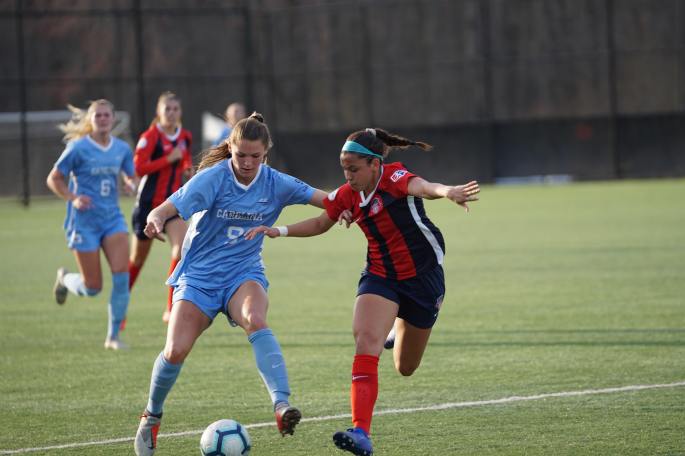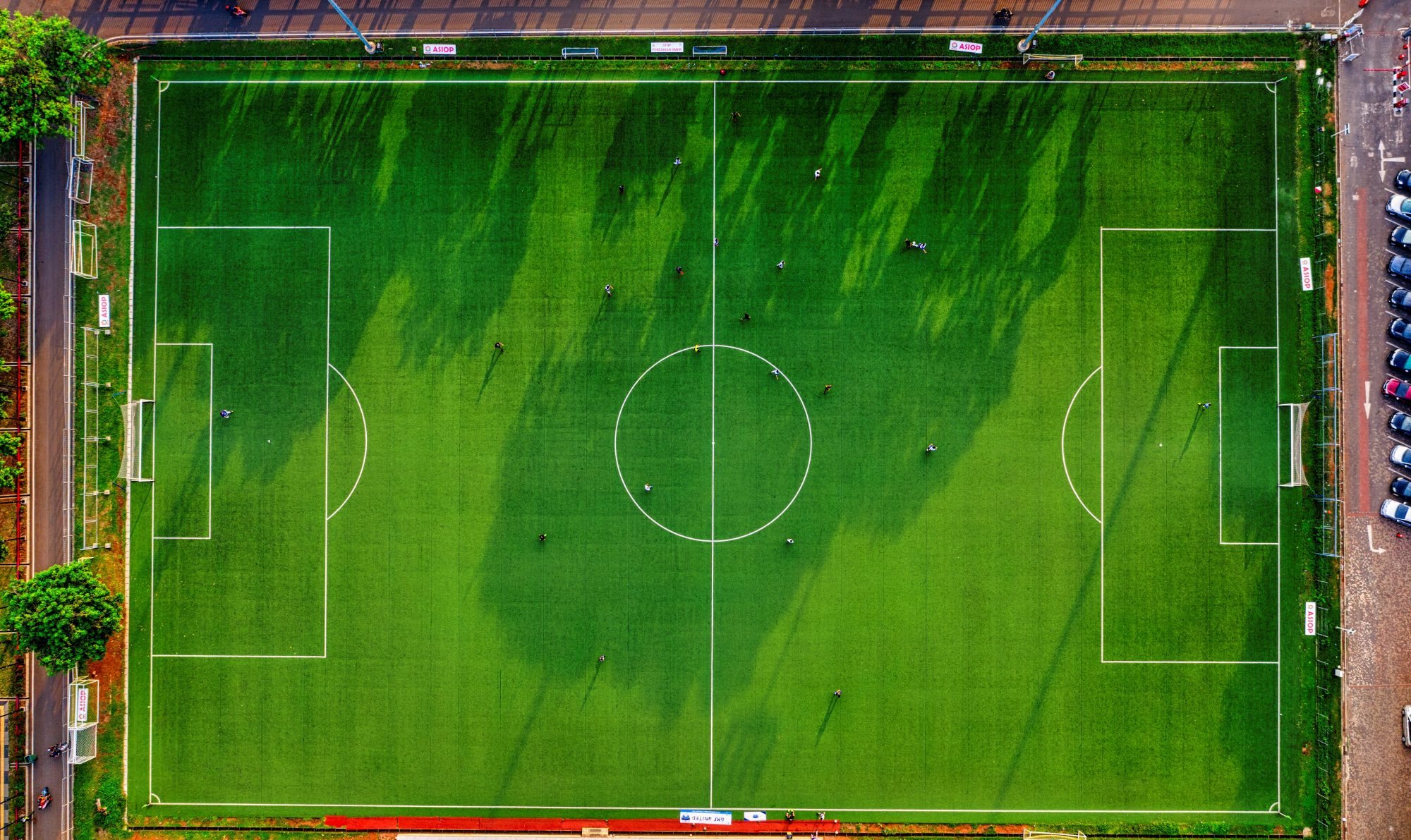
Over the past decade, the emphasis on attacking play in the beautiful game has grown and grown. Coaches and fans are increasingly more excited about the attacking moments of the game, rather than defensive moments. Defending has become an afterthought, and teams that set up to defend are often deemed “boring” and “dinosaurs” by fans around the world. But defending remains an integral component to the modern game, and often it can be seen that teams with the better defense structures (Atletico, Manchester City, etc.) often win more football matches. Here is everything you need to defend like a pro!
what is defending?
Embed from Getty ImagesThe emphasis on defending in the past few years has shifted over toward pressing. Teams press with varying intensities and varying heights on the field, but all have a common focus that players work toward to collectively win back the ball. Ultimately, it comes down to a matter of simplifying the press to the questions of where, when and how. Where should we press, when should we press there, and how should we press when we arrive. Although pressing may involve, and be led by a few select individuals, it is ultimately a collective art that all players must work toward together. But defending is far more than just pressing. Other important defending concepts include defending deep (i.e. in a low-block), defending in smaller numbers such as 1v1 or 2v2 situations, and defending outnumbered. Within all aspects of defending, regardless of whether the team is playing in a high pressing system, mid-block, or low-block, defending compact is integral to the art.
low block

Defending deep in a low block involves the defending team giving more time, space and often even respect to their opposition, allowing them to keep hold of the ball and pass it around. This may be an intentional strategy to cope with the pressure of playing against a stronger team, but it can also be used to sit off and manage specific players, such as incredibly fast ones like Adama Traore or incredibly skillful ones like Lionel Messi, who can leave you for dead if you get touch-tight. Ultimately, having a low-block means that these types of players may have less time and space to work their magic, by actually theoretically giving them more time and space to work their magic. That happens due to the limitation of space in advantageous areas on the field due to the team’s compact structure, eliminating space in between the lines and easy routes to goal when done correctly. Instead, more space is afforded toward the opposition’s own half and goal, further away from the defending team’s net. Like all defensive structures, a low-block or “defending deep” can still go wrong if one single player loses focus and doesn’t stick to their task. Coaches therefore need to make each player’s specific role in the defense clear, and give the players plenty of time to identify patterns of play in training. One of the very best of the art when it comes to defending deep is of course, Diego Simeone – the long-time manager of Atletico Madrid. Simeone has led his team to two UEFA Champions League finals, two UEFA Europa League trophies and one La Liga title.
Embed from Getty ImagesDuring his time in charge, the Argentinean manager has held true to a low-block, playing primarily in a 4-4-2 formation, which has recently become synonymous with this defensive ideology. Atletico’s compact, narrow approach forces their opposition to the outside, limiting the opposition’s ability to attack through central areas and get dangerous players like a ‘number 6’ or ‘number 10’ on the ball. This method of funneling their opposition out wide results in the fullbacks making a high number of tackles and interceptions per game. In the past, Juanfran and Filipe Luis were frequently at the top of Atletico’s charts in those categories. This season, as expected, it’s Lodi and Trippier at the top in terms of tackles per game, with only Koke attempting and completing higher numbers than Trippier per 90 minutes. Los Rojiblancos are fantastic at winning the ball back but they still take a very patient approach to defending. This is often one of the most important aspects to a low-block. Teams like West Ham who sit very deep may make a very low number of tackles. They simply position themselves on the field to intercept the ball or force their opponents into bad passes, shots from too far out, and just an array of bad decisions overall. This is the key to the low-block – forcing errors, rather than aggressive attempts to win the ball on a tackle or through pressing.
2v2 defending
Embed from Getty ImagesTheMastermindSite has written many articles about defending in 1v1 situations. Therefore this section will touch more on 2v2 situations up against counter attacks. However it is important to remember that 2v2 situations can often be broken down even further to 1v1 situations and the same set of principles can often be applied. Where the difference lies is in the notion of pressure vs. cover. In 1v1 situations, the initial decision may be about pressuring or remaining patient (i.e. disturb or delay). In 2v2 situations, it becomes more of a decision of who pressures and who covers, regardless of whether or not the team decide to slow the attack down or win the ball. On counter-attacks, the decision is usually to delay the attack, and allow for others to come back into the mix. But when defending in a 2v2, at least one player may need to “pressure” the player in possession, even if it is not necessarily what we would normally associate pressuring to be. The defender that pressures is generally the one that is closest to the player in possession of the ball, while the defender that covers is generally the one that is further away from the ball. They should remain in close enough proximity to have a watchful eye of the space and opposition players around the player in possession of the ball, even though they are not directly involved in the pressure. The covering defender should also position themselves with the foresight and the ability to step in if the pressuring player fails in their task, and with the ability to cut off a pass should one be attempted. Communication is also integral to success in 2v2 situations yet again. Defenders should communicate who pressures and who covers, and how the pressuring player should angle their approach (e.g. “show outside!”) to maximize the potential for the defending team to win the ball.
defending outnumbered

It’s probably self-explanatory what defending outnumbered incorporates – having at least one less defending player up against the attacking team in the moment. It can happen for a variety of reasons, such as having a player sent off, or succumbing to a quick counter attack and not being able to recover enough players in time. Teams like Borussia Dortmund carefully overload one side of the field, intentionally outnumbering their opposition on that specific side and then easily playing through the opposition. Whenever a team is defending outnumbered, it is important to remain compact (close together) and delay the attack until more recovering defenders are in place. Delaying is often done through careful body positioning to cut off angles of space and available passing options, that an attacker could advance into or utilize, limiting the team’s ability to progress at speed. Tyrone Mings for Aston Villa is one of the best of the art. When defending in 2v1 or 3v2 situations, he is excellent at positioning his body to cut off the attacker’s options, timing his tackle to perfection at the exact right moment. This is ultimately more difficult to teach young players than other aspects of defending, but skills like patience, composure, and timing of the tackle are all starting places that can allow defenders to develop an understanding of how to defend when outnumbered. Many of the skills discussed in the 2v2 section above can also be applied when defending outnumbered, such as the initial decision of who should pressure, who should cover, plus the when, where and how in a 3v2, 4v3, etc., situation.
defending compact

Finally, if defending was to be wrapped up into one specific word, it would probably be the word “compact.” Compactness refers to the structure of the entire team, in which they remain close together and eliminate space as a unit. Compact teams become narrow in their blocks, forcing the opposition to the outside. Teams can also be compact in attack, but it is for different purposes. Ultimately, when defending, teams want to make the field smaller. When attacking, teams want to make the field bigger by “stretching” the field. Therefore, a compact attack such as Borussia Dortmund’s overloading of one side, are rare occurrences and usually still involve some method of switching play to create that width and depth.
Compactness also means that teams defend as a collective unit. They move together, shifting and sliding with the play and cutting off passing lanes for the opposition to go forward. Everyone moves forward and backward as a unit, and so communication is again integral to the art of when to drop, when to step up, and when to hold. Compactness is often associated with low-blocks most prominently, but is also important to all aspects of defending, including pressing and all of the sections above.
concluding thoughts
Defending like a pro is an art that takes many years to master. But with these tips in mind and examples from professional teams and players, you will be able to take your game to the next level. Thanks for reading and see you soon!
So there it is! How to defend like a pro with Xhulio Zeneli and Rhys Desmond breaking down all of the best tips to improve your knowledge of defending both as a team and as an individual player. Be sure to follow on Twitter @mastermindsite and subscribe to never miss an update.
->


4 thoughts on “How to Defend like a Pro”